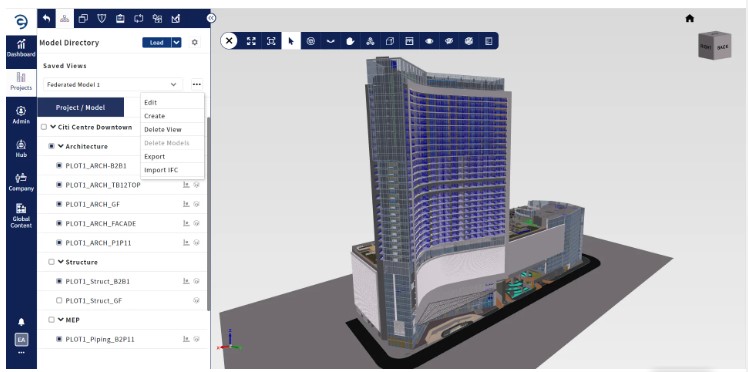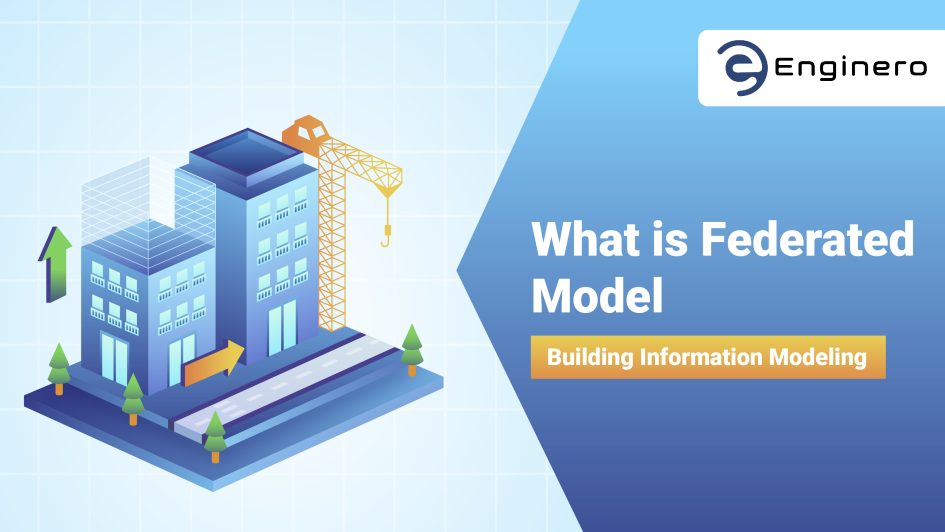A Federated Model is the integration of multiple discipline-specific models into a single, cohesive model. There are many disciplines such as Architecture, Structural Engineering, Mechanical, Electrical, and Plumbing(MEP).
Each discipline creates its detailed model of the building or infrastructure project. These models are then combined into the federated model.
This helps to provide a comprehensive view of the entire project.
In this blog, you will learn about,
- Understanding Federated Model
- Why Federated Model Matters
- Perks of Federated Model
- Project Embracing Federated Model
- Enginero’s Role in Facilitating the Federated Model
The construction industry has been embracing unwavering innovations in recent times, pushing primitivity aside. The way of connecting and collaborating for a project has seen unprecedented ways, which has catalyzed the respective aspects of construction.
Building information modeling has been one imperialistic approach that the engineering realm has witnessed in recent decades.
The Federated model is the one we are about to highlight here. Having a credible application to manage this models is an added advantage, thereby witness Enginero’s eminence in pushing limits above the bar with model management.
Understanding Federated Models
Before jumping into the models, let’s look at BIM! What is it?
Having prevailed in the realm for almost decades, BIM is getting frenzied now by being recognized and adopted in recent times.
A comprehensive design for the construction project is BIM, in short, but it has technology behind it to enhance lifecycle management for the construction project.
Each aspect of the building is pinned with BIM, which will render paramount assistance throughout the building’s lifetime.

BIM has enforced the teams to create various designs and models using vital software applications and embrace an ideal aspect of elevating and maintaining structures.
Engineering and construction are clusters of multiple teams and organizations, wherein respective teams create designs and models for diverse software applications.
Clubbing these models from multiple software solutions to create one single model eventually reveals a complete construction model.
This way of clubbing models from diverse applications is called the Federated Model.
The model do not alone bring models together; this way of aggregating models brings the teams closer under a canopy.
For example, a construction unit will have an architectural team, an MEP team, and structural teams, and each team will create its model.
Clubbing all these models from the teams will reveal a complete model, and these teams can now connect and engage in streamlined work. Ideal coordination and collaboration among these teams have a greater impact on the project without any misconceptions.
Why Federated Models Matters
Federated models render required significance to the construction industry, which can effectively impact progress and thereby streamline progressive outcomes.
Here are certain aspects of BIM-federated models to enhance cohesive project objectives.
3D model integration in Federated Model
Federated models enhance 3D model integration from diverse points of the engineering realm.
This type of model federates the architectural, structural, and MEP models into one cohesive model and represents them better than from isolated perspectives.
When this aggregates the models into one whole 3D model, it gives the fortunes of executing the plan well in the project.
Added to that, the 3D model gives the project holders comprehensive visualization, improved coordination, extensive analyzing abilities, and enhanced collaboration among teams.
Data Collaboration in Federated Models
Data collaboration is one added advantage of model; as is already said, we make it more clear here.
The Federated Model is the club of multiple disciplines in the construction industry; the 3D Model has its team behind it that must be connected to enhance better project outcomes.
This Model articulates interoperability between disciplines by bringing all the teams under one canopy.
This level of interoperability streamlines more data exchange, creates a unified data structure, promotes transparency between the teams, and lastly, keeps the team aware of the technical updates happening around the project.
Perks of the Federated Model
Seamless Collaboration
This BIM-based model incorporates seamless cooperation between the teams, breaking primitive barriers.
Each team from the respective discipline gets room for real-time collaboration and communication among them, and this eventually saves effort and time spent connecting for streamlined work.
Clash Detection and Resolution in Federated Model
When the models are grouped along with the teams, it becomes easy for the team to detect clashes in the models. Upon detecting the clashes, they can work progressively to eliminate them and construct a perfect model.
Just imagine the time saved by detecting potential clashes in primitive methods. The Model has moved all the primitivity aside to cultivate a new way of construction.
Data-Driven Decision Making in Federated Model
The federated model gives a cluster of data related to the projects in multiple formats, and this renders extensive assistance when it comes to making any decisions.
This data-driven decision-making process from this model type will regulate better project management, right from designing to executing them.
Projects Embracing Federated Models
Having said more about the model, it would be more appealing if we revealed to you the famous projects that used the model in their construction progression.
The Shard, London
- This famous skyscraper in London has embraced the BIM federated model for its elevation.
- By using the 3D model integration, this construction project has notably reduced the time and cost of reworks and has been executed in less time than expected.

Dubai Mall expansion
- Dubai is known to be a phenomenal country for construction and buildings. Within this, the Dubai Mall expansion has executed the federated model for the expansion to streamline collaboration and communication.
- The 3D model integration has improved project coordination by bringing structural, architectural, and MEP teams together and carrying out proper project execution.

Enginero’s Role in Facilitating Federated Models
Having mentioned in the depth of the model, how about having an application to regulate the federated model and 3D model integration? Enginero is here.
This ideal construction lifecycle management application streamlines model storage, model display, clash detection and solution, RFI management, data exchange between teams, role assignment, and managing roles, streamlined collaboration, data reporting, and more.
Enginero excels at providing you with extensive model management for the federated model and lets you explore the perks of models in the construction industry.
Conclusion: Embracing Innovation in Construction
Innovations are inevitable, and updates are happening without any hindrances. Regarding this, utilizing the model for the construction process will provide more opportunities to elevate a structure with significance by your side. With AI and ML reaching every nook and corner, it can effectively affect the construction process.
Be a forerunner in exploring one such impressive attribute of construction with Enginero by your side.


Leave a Reply